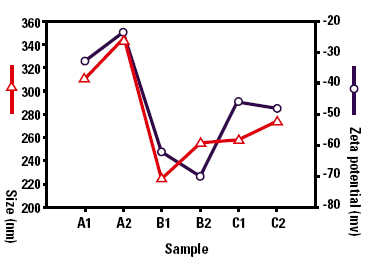Measurements of zeta potential, along with particle size, can be used to predict the stability of fat emulsions.
What Lipid Emulsions are Used For
Lipid emulsions are given intravenously for:
- Patients with difficulty in ingesting food orally
- Transport of lipophilic drugs
- Controlled release of drugs
- Decreasing the adverse reactions to drugs
- Improved targeting of drugs
The Importance of Zeta Potential for Colloids
Control of the zeta potential and size enables control of the characteristics of colloidal particles
- In production a high zeta potential prevents aggregation of the emulsion, increases stability to give a shelf life greater than 2 years.
- The Malvern Panalytical Zetasizer measures both zeta potential and particle size in the same instrument, which reduces the laboratory space required and the equipment cost.
Data Output from the Zetasizer
- Comprehensive choice of Data and graphs output
- Graphs are obtained in full color and can be used directly to produce slides or reports.
Automation and Ease Of Operation Plus Versatility
- Simplicity of use opens new possibilities for using these instruments at production lines or in quality control departments.
- Flexibility for research is retained and parameters may still be set manually for advanced users.
Example Data
Figure 1. shows the measurement of size and zeta potential for a variety of lipid emulsions stabilized in different ways. Product A2 has the largest size and lowest zeta potential. These measurements correlate well with the fact that creaming was observed after 6 months storage at room temperature.

Figure 1. Zeta Potential and particle size data for stabilized lipid emulsion samples.

This information has been sourced, reviewed and adapted from materials provided by Malvern Panalytical.
For more information please visit Malvern Panalytical.